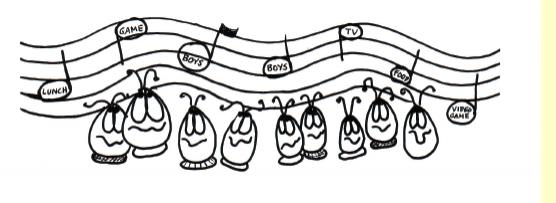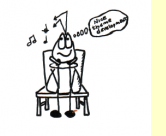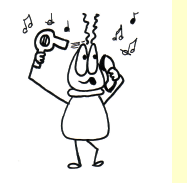Summer Reading for Music Teachers
iBooks List
We have been creating iBooks versions of some of our favorite books. You can project iBooks for your students from your iPad. If students love the So-mi storybooks, they can get them at home. The following is a list of the iBooks from Themes that are available.
| Action Songs Children Love 1 | https://books.apple.com/us/book/id1426029074 |
| Recorder Resource Student Book | https://books.apple.com/us/book/id1365835536 |
| 1. So-me Goes Missing | https://itunes.apple.com/us/book/id1420678863 |
| 2. So-me and the Spider | https://itunes.apple.com/us/book/id1420684226 |
| 3. So-me Meets the Boss | https://itunes.apple.com/us/book/id1420760899 |
| 4. So-me… Oh and Romeo | https://itunes.apple.com/us/book/id1420774870 |
| 5. So-me at the Pole | https://itunes.apple.com/us/book/id1421424313 |
| 6. So-me in Space | https://itunes.apple.com/us/book/id1421479405 |
| 7. So-me and the Dance | https://itunes.apple.com/us/book/id1421481424 |
| 8. So-me and his Secret | https://itunes.apple.com/us/book/id1421490839 |
| 9. So-me Goes to the Party | https://itunes.apple.com/us/book/id1421485904 |
| 10. So-me and the Monster | https://itunes.apple.com/us/book/id1421488195 |
| 11. So-me Finds ‘Dough’ | https://itunes.apple.com/us/book/id1421492086 |
| 12. So-me and the Princess | https://itunes.apple.com/us/book/id1421495093 |
Summer Reading for Music Teachers
There’s been a thread on the Musicplay Teachers Group on Facebook about how to help a child who is profoundly deaf. I think it would be inspiring and very probably give us good teaching ideas to read Evelyn Glennie’s autobiography. Evelyn Glennie is the British percussionist who has had an amazing career despite being profoundly deaf. LINK to “GOOD VIBRATIONS” BY Evelyn Glennie.
Good Books for Teachers
I’ve borrowed this list from Reader’s Digest – Inspiring Books for Teachers
https://www.rd.com/culture/inspiring-books-for-teachers/
‘1. Teach Like Your Hair’s on Fire: The Methods and Madness Inside Room 56’
If you’ve ever doubted the impact a single teacher can have on a group of children, you need to read this book. For more than 30 years, author Rafe Esquith was a fifth-grade teacher at Hobart Elementary in central Los Angeles, one of the most impoverished school districts in the country. In this book, Esquith shares his techniques for building trust, respect, and passion for education among his students—techniques that have not only earned him numerous awards and international recognition, but have helped droves of students succeed beyond expectation.
‘2. The Freedom Writers Diary: How a Teacher and 150 Teens Used Writing to Change Themselves and the World Around Them’
Published in 1999, this book is a collection of writings by the students of Erin Gruwell, a then 23-year-old new teacher at Long Beach High School in Long Beach, California, who was assigned a class of so-called “unteachable” students who were trapped by gang violence and racial tension. To reach them, she assigned literature they could relate to, brought in speakers who could engage them, and gave each of them a blank composition notebook where they could share, anonymously, their thoughts and experiences. Despite the odds against them, all 150 of her students graduated from high school, and some went onto college and established rewarding careers. The book also spawned a 2007 movie, Freedom Writers, starring Hilary Swank.
‘3. The First Days of School’
New and veteran teachers alike sing the praises of this book by education experts Harry K. and Rosemary T. Wong, now in its fourth edition. Revered by thousands of school districts and in hundreds of countries, this book walks teachers through proven strategies for classroom management and organization that can be applied to students in any grade, from preschool through college. As the title suggests, the book reinforces the idea that the methods teachers establish during the first days of school will define whether they fail or succeed, and can help teach even the most experienced educators a few new tricks.
‘How to Win Friends and Influence People’
Whether you’re dealing with five-year-old kids or 30-year-old adult learners, teaching is, at its core, a people profession. Considered one of the most influential self-help books ever published, this book is widely praised by teachers across the country. Published in 1936 by American writer and lecturer Dale Carnegie, the book provides a series of simple yet effective strategies for improving one’s self-confidence, developing leadership skills, and reducing the cycle of stress.
‘The Hidden Lives of Learners’
This book, which is the result of four decades of research by New Zealand Emeritus Professor and author Graham Nuthall, investigates the three powerful aspects that dictate a student success: teacher-student interaction, peer influence, and a student’s personal home life. His research into how low-ability students can learn as well as high-ability students is nothing short of groundbreaking, and has major implications when it comes to the vexation of standardized testing and education reform.
‘Outliers: The Story of Success’
This best-selling book by esteemed journalist Malcolm Gladwell will resonate with anyone who wants to understand how people ultimately achieve greatness. In the book, Gladwell investigates numerous factors that contribute to extreme levels of success, such as that achieved by professional athletes, influential business people, and celebrities. The book explores how factors like birth month, practice, culture and hidden advantages can shape the lives of extraordinary individuals who excel beyond any reasonable understanding. \\
‘I Am Malala: The Girl Who Stood Up for Education and Was Shot by the Taliban’
In modernized counties, we sometimes forget that for many children around the world, education is not a right—it’s a privilege. Perhaps no one understands that more than Malala Yousafzai, who, at age 15, was shot point-blank in the head by the Taliban, simply because she wanted to attend school. Miraculously, she survived, and went on to become a Nobel Peace Prize winner and a powerful voice for girls’ education. This inspiring memoir, which she penned in 2013 with British journalist Christina Lamb, highlights the strength of a family’s love and reminds readers of the never-ceasing power of education.
‘What Teachers Make: In Praise of the Greatest Job in the World’
In 2002, former teacher Taylor Mali crafted a poem called “What Teachers Make.” He had written the poem in response to a condescending lawyer who had asked him, “Be honest. What do you make?” The poem went viral on social media, and is the basis for this witty and inspiring book of the same name. Through a series of anecdotes and poems, Mali shares his experiences as a classroom teacher and helps to remind teachers why their job is so important.
‘Teaching Outside the Box: How to Grab Their Students by Their Brains’
This book by teacher-turned-author LouAnne Johnson considered by some educators as one of the most influential strategy guides even written for teachers. In it, Johnson, who is best known for her book My Posse Don’t Do Homework (renamed Dangerous Minds after it spawned the movie in 1995), shares her honest and effective methods for improving classroom management, engaging students, and advancing critical thinking.
‘Today I Made a Difference: A Collection of Inspirational Stories from America’s Top Educators’
This collection of stories, compiled by editor Joseph Underwood, serves to answer two essential questions: why teachers teach, and why they decided to make teaching a career, despite the low pay and long hours. The book is based on the real-life stories of all 28 of Disney’s 2004 Teacher of the Year Nominees, and will inspire new and experienced teachers alike with its honest, inspiring and refreshing look at the obstacles teachers overcome on a daily basis.
Taming the Anthill
This is one of my favorite books on teaching elementary music. Here’s an excerpt from “Taming the Anthill” by Jean Spanko to give you some fun reading to do this summer.
Taming the Anthill, by Jean Spanko
If you’ve never read this book, you should. If you have read it, read it again. It’s been around for a while, but the experiences of this teacher who got thrown into Junior High General Music will speak to you, whether you’re a brand new teacher, or have been teaching 30 years.
Click to Link to Canadian Site Download Book from US SITE
Chapter 3 – LISTENING OVERVIEW
I Heard That Before
IT’S BORING!
Beethoven was a musical genius whose music touches our very souls. Yet eight out of ten junior high/ middle-schoolers will tell you that his music is boring. Why? The answer is complex, but it probably is influenced
by all the stuff muddling around in kids’ heads.
“I’ll bet everyone notices my nose.”
“I’ll just die if dad makes me get my hair cut.”
“I wonder if we’ll beat Hillside today?”
“I’m starved. Oh yuk, this is pizza-dog day.”
Some texts suggest making the initial presentation of a listening lesson an uninterrupted playing of the music. I did. I also referred a jabbing match, confiscated enough cosmetics to start my own discount store, and watched helplessly as The Flying Dutchman Overture lost to the fidgets. Bad idea.
It’s unfair to yell at your students for not listening properly if you don’t help them learn how to listen. Test yourself first. Play a recording of an unfamiliar piece in a style you are not terribly fond of. See how long you can sit perfectly still and concentrate. How long before your mind drifts and your body needs to move? Divide that by five and you’ll be close to the attention span of your students.

CASUAL LISTENING
On the first day you plan to present a listening lesson, have some music playing at a moderate volume as the class comes in. Anything middle-of-the-road will do. You’ll hear a few questions or remarks, but play deaf. Later in the period, when you’re ready to begin the listening lesson, ask a few questions about the music.
“Did it have a synthesizer bass or an electric guitar bass?”
“Can you hum the melody?”
“What instruments were featured?”
Let them sweat for a few seconds then announce that they were listening correctly; they were listening casually. The music was just a background for whatever they chose to do–visit, get out books or look out the
window. Ask the class to give examples of situations in which they listen casually. (Talk on the phone, do homework, ride in the car, shop at the mall.) Does it matter what song plays on the radio as you have your teeth worked on? Not really. Casual listening is barely listening at all. It is more a sound blanket to make us feel OK.
MOOD LISTENING
“Can you think of some situations where the music is designed to get us in a specifi c mood or feeling?”
Answers may come a bit slowly, but before long your list will include TV shows, movies, dancing, skating, maybe even church! We may not know it, but we are listening more carefully to this kind of “mood” music. If we weren’t, we wouldn’t get the variety of feelings we do from these activities.
Now it’s time to ask:
“What are some of the things music can do to give us different feelings as we watch TV, dance or attend a church or temple service?” Make a list of the answers for later use. Don’t announce it, but make your list in categories such as tone color, dynamics and tempo. Demonstrate mood
listening/feeling/responding by playing a march. Tell students to “let your
fingers do the marching–on your desk, not on your neighbor, thank you.” After a half minute of this tell them, “Let an arm and a foot join in.” Then, “Let’s see if your whole body can follow the beat.” Lead a spirited single fi le march around the room. (Be prepared to escort the fi rst few students out of their seats.) As the march nears the end lead students back to their seats. Follow with a discussion about why this was good march music.
CONCENTRATED LISTENING
We can also listen to music to enjoy it all by itself. Just listen. (This will come as a revelation to a few.)
Listen to what?
Start simply, no Beethoven yet. Name a Top 40 song and ask the kids to write as many of the lyrics as they can remember. (Offer a plus to any kid who brings in the complete lyrics the next day.) Next, play the fi rst verse
and chorus of the song and watch the concentration as they scribble away!
Here’s another approach. Play an excerpt from Tomorrow from the musical Annie. Ask the kids to count the number of times “tomorrow” is sung.
“That’s not very musical,” you say. True. We’re taking it in very small steps. But look what’s next.
Play Tomorrow again. Ask students to draw the melodic contour of each “tomorrow” they hear. (Show them how.) When the excerpt is over, ask them which “tomorrows” have the same shape and which ones are
different. Ask if the difference was caused by the pitch or the rhythm or both. Now we’re getting somewhere.
Here are a few follow-up projects to go with your introduction of casual, mood and concentrated listening.
Casual
Carry a note pad around with you for one day. Make a list of every casual listening event that happens. Note the approximate length of each event.
Mood
Choose two events that will have mood music. Give examples of how the music helped you to have the specific feelings or moods you had.
Concentrated
Listen to two radio stations you do not usually listen to–fifteen minutes each. List the names of the stations, the names of the pieces and the style of each (country, gospel, classical, rock, pop or jazz, for example).
Give three reasons you think the pieces are in the styles you say they are.
TIPS FOR SUCCESS
• Make your first listening session thirty seconds long. Have students time it.
• Keep the focus on musical sounds. A little historical perspective goes a long way in junior high.
• Make the “pleasure connection.” Connect listening sessions to a recall of pleasant and familiar feelings
whenever possible:
“I heard one of those on MTV last night.”
“That bass line goes just like the one in . . . .”
“They play that on the TV-5 weather. What is it?”
“It sounds like Star Wars but not quite. What’s different?”
• Do a few selections in depth. A big attraction of pop music is its familiarity. If Sam listened to Mozart as often as he does Van Halen, Mozart wouldn’t sound a bit strange. Choose a few quality pieces and use them several times each, with differing focus. By the end of the term these selections will be settled in.
 • Beware of overload. When the papers start rattling, the desks begin to squeak and the noise level crescendos, stop! Don’t preach your favorite sermon, just stop. Switch to some other activity and resolve to make the next listening lesson shorter and clearer.
• Beware of overload. When the papers start rattling, the desks begin to squeak and the noise level crescendos, stop! Don’t preach your favorite sermon, just stop. Switch to some other activity and resolve to make the next listening lesson shorter and clearer.
• Avoid the rock versus classical debate like the plague. You’ll lose. When they’re ready, the debate is one of preference for and comparison between rock and classical (or gospel or country or anything).
• Troubleshoot your disasters. Be honest. Had it been a rotten day anyway? Were you fully prepared or did the class have a chance to get distracted while you hunted for the record or sent Jane dashing to the office to run off worksheets? Junior high/middle-schoolers are little noted for their unmerited respect of the teaching profession. If you ask for trouble, they’ll give it to you! You can fool some of the people some of the time, but never an anthill full of seventh or eighth graders
COMING UP
The next three chapters feature examples of concentrated listening preparation and listening projects focused on tone color, form, and style.
Download Taming the Ant Hill in Canada USA – Taming the Ant Hill
What are you reading this summer – share your favorite books for music teachers at Musicplay Teachers Facebook Group!
